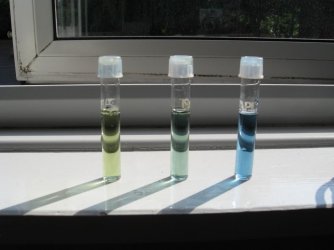A little under a year ago I decided to do an experiment to see why there was such a large discrepancy between my tap water and my tank. I'd long since suspected that my sand substrate was the culprit as at the time I was running another tank which had gravel as substrate and the pH in that tank didn't fall far from the tap level at all.
So, I got myself 3 drinking glasses, washed both and filled them both with boiling water to sterilize them. I filled each with an equal amount of dechlorinated water

I tested the pH on all three - all were exact.
Next I took a handful of sand from my Rio240 and a handful of gravel from my Rekord 800. I washed both well

I added the sand to glass one, the gravel to glass 2 and left glass 3 with just the plain water

I left all three glass uncovered on a shelf and tested the water daily
Over the period of around a week I gradually watched the pH in glass 2 (with gravel) fall and then become stable. Glass 1 though continued to fall though




The test tubes are from left to right - left being glass 1 with sand, middle being glass 2 with gravel and right test tube being the plain glass.
After around a week I ended the experiment as I felt I'd proved my point. Had I of carried on I truely believe that the pH in glass 1 would have fallen further
this is what my sand is

So, I got myself 3 drinking glasses, washed both and filled them both with boiling water to sterilize them. I filled each with an equal amount of dechlorinated water

I tested the pH on all three - all were exact.
Next I took a handful of sand from my Rio240 and a handful of gravel from my Rekord 800. I washed both well

I added the sand to glass one, the gravel to glass 2 and left glass 3 with just the plain water

I left all three glass uncovered on a shelf and tested the water daily
Over the period of around a week I gradually watched the pH in glass 2 (with gravel) fall and then become stable. Glass 1 though continued to fall though




The test tubes are from left to right - left being glass 1 with sand, middle being glass 2 with gravel and right test tube being the plain glass.
After around a week I ended the experiment as I felt I'd proved my point. Had I of carried on I truely believe that the pH in glass 1 would have fallen further
this is what my sand is





 /www.unipacpet.co.uk/aquatic/micro-gravel/
/www.unipacpet.co.uk/aquatic/micro-gravel/